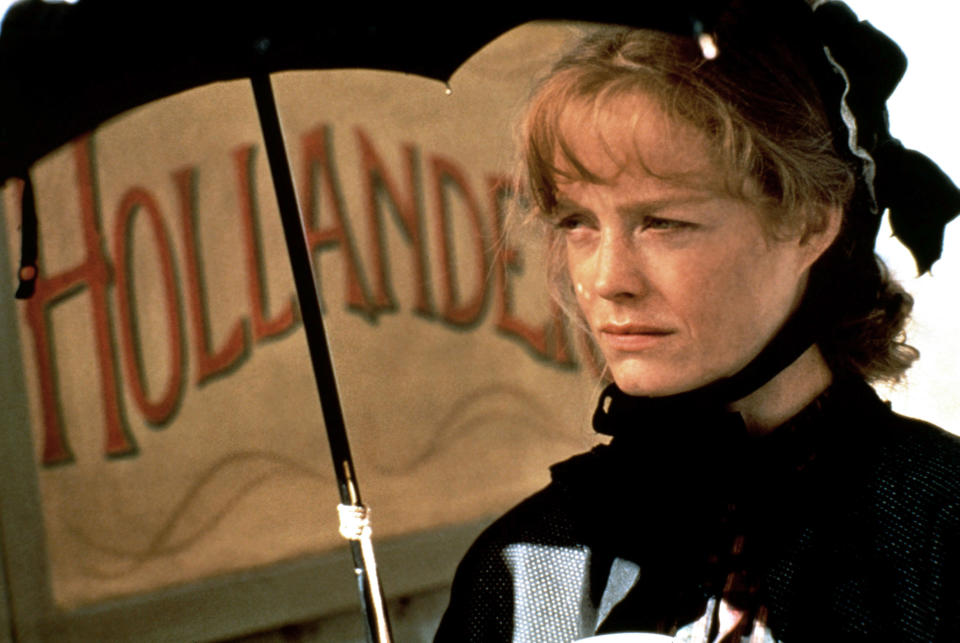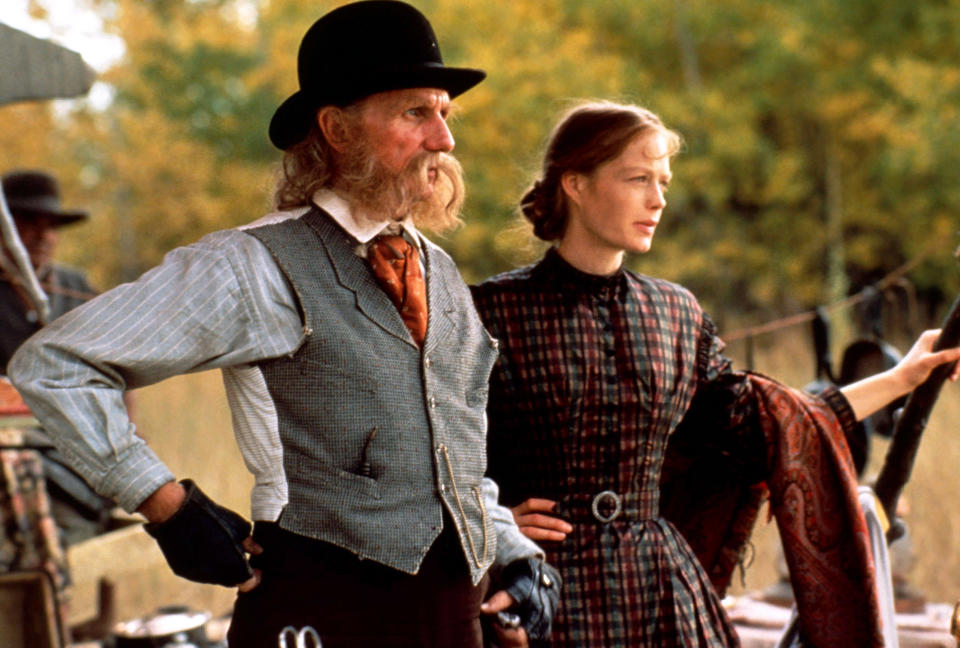One of the Greatest Westerns Ever Made Is Now Streaming After Decades in the Wilderness

Throughout most of the 1980s the Western was assumed to be a dead genre, certainly compared to the central role it once played in Hollywood’s construction of a national mythology. While there were occasional outliers like Lawrence Kasdan‘s “Silverado” and Clint Eastwood‘s “Pale Rider,” for the most part the responsibility the genre had to reflect and shape American values was taken up by either science fiction movies like “The Terminator” (which fulfilled the Western’s function as an exploration of the changes wrought on society by evolving technology) or urban cop films like “48HRS.” and Eastwood’s “Dirty Harry” sequels, which transposed the form’s archetypes and moral questions to a contemporary setting. Although the decade closed out with the successful “Young Guns,” that film was an anomaly whose success probably had more to do with its cast of attractive teen idols.
Then something funny happened in the early ’90s: Right as Hollywood seemed to have given up on the Western, it came roaring back with a vengeance and yielded the most varied, complex, and satisfying group of films since the glory days of John Ford and Delmer Daves. The box office and awards success of Kevin Costner’s “Dances With Wolves” in 1990, followed by Clint Eastwood’s triumphant return to the genre in 1992 with “Unforgiven,” suddenly made Westerns commercially viable again, and filmmakers who had been biding their time were able to will their dream projects into production. Lawrence Kasdan returned to the genre for the underrated and ambitious “Wyatt Earp,” Walter Hill made two of his best films with “Geronimo: An American Legend” and “Wild Bill,” and talented directors like Jim Jarmusch (“Dead Man”), Sam Raimi (“The Quick and the Dead”), and Melvin Van Peebles (“Posse”) made Westerns as different from each other — and as equally nourishing — as one might expect.
More from IndieWire
One of the best of the ’90s Westerns has also been one of the most difficult to see, but a special edition Blu-ray release in December and a streaming premiere this month have rescued it from years of inaccessibility. When writer-director Maggie Greenwald’s “The Ballad of Little Jo” was released in 1993, its relationship to the other Westerns of the time was a bit of a coincidence — Greenwald had written the script before “Unforgiven” — but there’s no question that her film, like the best 1950s Westerns of Budd Boetticher, Howard Hawks, and Sam Fuller, benefited from the comparisons and contrasts enabled by being part of a recognizable tradition. Like those directors, Greenwald was brilliant at using the language of the Western as a shorthand, expressing her point of view not only by what she depicted and how but by where her treatment of the material paid tribute to the Westerns that had come before and where it deviated.
“The Ballad of Little Jo” is based on the true story of a society woman (played brilliantly by Suzy Amis in a performance that deserves to be spoken of in the same breath with James Stewart’s work in the Anthony Mann Westerns) who, shunned by her family after giving birth out of wedlock, rides West and reinvents herself as a man – Josephine Monaghan becomes “Little Jo” Monaghan, a successful sheep farmer who, like the characters in “Shane,” “Heaven’s Gate,” and dozens (hundreds?) of other earlier Westerns, defends her land against an evil corporation. Along the way, she sidesteps the advances of a young woman who sees her as a potential husband and carries on a romance with a Chinese laborer (the only person who knows her true gender) while becoming friends with a guide and mentor named Badger, played by Bo Hopkins in a role that can’t help but evoke associations with Sam Peckinpah’s “The Wild Bunch.”
The casting of Hopkins gives the viewer a clue to what Greenwald is up to, as she slyly references and honors not only Peckinpah but a whole history of American Westerns at the same time that she finds new directions for the genre. Much as Hopkins retains the strengths of his performances in Westerns like “The Wild Bunch,” “The Man Who Loved Cat Dancing,” and “The Culpepper Cattle Co.” while also revealing new layers of sensitivity, the film as a whole delivers the satisfactions of Westerns — “The Magnificent Seven,” “The Gunfighter,” “Shane” — that explore both the liberation of a life defined by rugged individualism and its limitations, but deepens and expands on the mythology. Part of this is inherent in the premise, and most of it is due to Greenwald’s probing intelligence and unerring visual sense.

Most Westerns are about masculinity and how America defines what it means to “be a man,” and many of the best entries in the genre have been films that delve into the contradictions and complexities of the question. By telling the story of a woman who lives her life as a man in the old West, Greenwald explores traditional ideas of masculinity and femininity through a different lens than just about every other Western ever made, even ostensibly female-driven works like “Bad Girls” and “The Quick and the Dead” which, while both have considerable strengths, don’t really engage with the issue on a deep level. Like most Westerns, “The Ballad of Little Jo” takes place in a world where maleness is glorified as a source of power and progress, a fact that Greenwald sharply interrogates via the unique perspective Little Jo’s character provides. Greenwald asks the viewer to consider and reconsider ideas many Westerns (and American films in general) take for granted by posing two simple questions: What does Little Jo gain by becoming a man, and what does she lose?
Greenwald uses familiar conventions both the traditional way and with a spin that gives them a whole new dimension. One of the hoariest cliches in the Western, for example, is that of the “redemptive woman,” the schoolmarm or minister’s sister who exists in the movie to civilize the hero and help him assimilate into society. In “Little Jo,” the redemptive woman is a man, but by making him Chinese — and therefore “lesser” and isolated in the eyes of the white men in the film — Greenwald plays with ideas of power, gender, race, and economics (Jo’s lover works as her handyman) and explores how they intersect in fluid and fascinating ways. The ways in which the viewer is expected to understand these issues are irrevocably affected by seeing them through the eyes of a woman who is pretending to be a man; long before the end of the movie, the line between “male” virtues and “female” ones — a defining feature of many classical Westerns — has been satisfyingly and provocatively blurred.
The pleasures of the film are not merely or even primarily ideological; part of Greenwald’s greatness is how organically woven into the narrative these ideas are. There’s nothing anachronistic about the film, even though, like all great period movies, it’s an equally valuable reflection of the time in which it takes place, the time of its release, and the time in which you’re watching it. Greenwald has the confidence not to force or overstate her ideas but just sets the drama in motion and lets the audience draw their own conclusions.

She also provides a textured and expressive visual experience for the viewer that makes “The Ballad of Little Jo” one of the most purely gorgeous independent films of its era, and also a Western with a distinct look. Other directors had taken pleasure in the small details and nuances of day-to-day living in the old West — Robert Altman in “McCabe and Mrs. Miller,” Walter Hill in “The Long Riders,” Budd Boetticher in his detailed depictions of what it really meant to be a cowboy tending to a horse — but Greenwald takes it as far as anyone ever did, focusing not only on where Little Jo lives, but how and why, and how the simultaneously beautiful and forbidding landscape informs her choices. The movie is filled with specific pieces of costume and production design that allow the viewer to ponder the frontier existence in all its particulars, not just its sweeping vistas; it’s an intimate approach that perfectly complements Greenwald’s efforts for us to see everything through Jo’s perspective.
At the same time, “The Ballad of Little Jo” has a sweeping, epic quality that belies its limited budget, as well as a giddy embrace of some of the Western’s most basic pleasures. When Little Jo, in a sense, “conquers” her territory and succeeds on both her own terms and society’s, it’s immensely satisfying, and her sense of freedom is intoxicating. Yet just as Gregory Peck in “The Gunfighter” or the guns for hire in “The Magnificent Seven” are trapped in their roles, Jo is trapped by successfully becoming a man — she can’t escape her role any more than Steve McQueen could escape his. Greenwald ends the film with an allusion to another great Western, John Ford’s “The Man Who Shot Liberty Valance,” with her own take on the idea that “when the legend becomes fact, print the legend.” Like everything else in the film, Greenwald’s perspective on this topic is complex, ambivalent, and, to a degree, open-ended, inviting the audience to continue the discussion after the film is over.
In a sense, Greenwald is doing what the best Western directors have always done despite the “revisionist” label erroneously attached to the ’90s films in the genre. The best Western directors have always been revisionist — John Ford cleverly subverted the idea of the redemptive woman back in 1939, for example, when he made her a prostitute in the same movie where he made the villain the most extreme representative of capitalist philosophy. Like “Stagecoach” — or “Red River,” or “High Noon,” or “Buck and the Preacher,” or any of the other all-time great Westerns — “The Ballad of Little Jo” looks both back and forward.
Also like those films, it’s a singular personal statement. Given that Greenwald was the first woman to write and direct a wide-release American Western in the sound era, it’s hard not to draw parallels between her own journey and Little Jo’s, forging her way forward in a male-dominated field and choosing what to retain and what to discard — and like her heroine, showing everyone else how it’s done. One doesn’t need to know anything about Greenwald or the production history of her film or even its context as a ’90s Western to enjoy it, though; it stands on its own as a masterpiece that has always deserved to be better known and more easily accessed. Its renewed availability is a cause for celebration and an opportunity to rediscover an American classic.
“The Ballad of Little Jo” is currently streaming at Kino Film Collection and is available on Blu-ray from Kino Lorber.
Best of IndieWire
Sign up for Indiewire's Newsletter. For the latest news, follow us on Facebook, Twitter, and Instagram.

